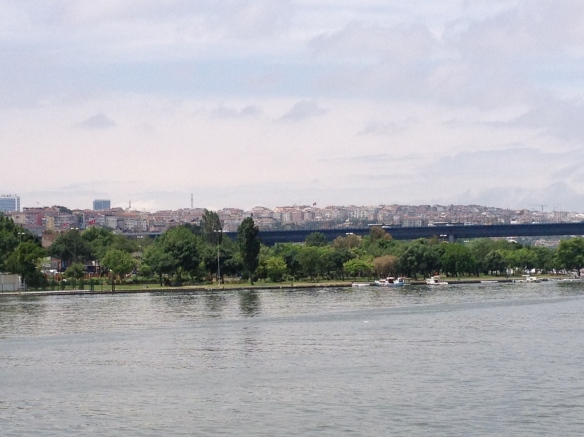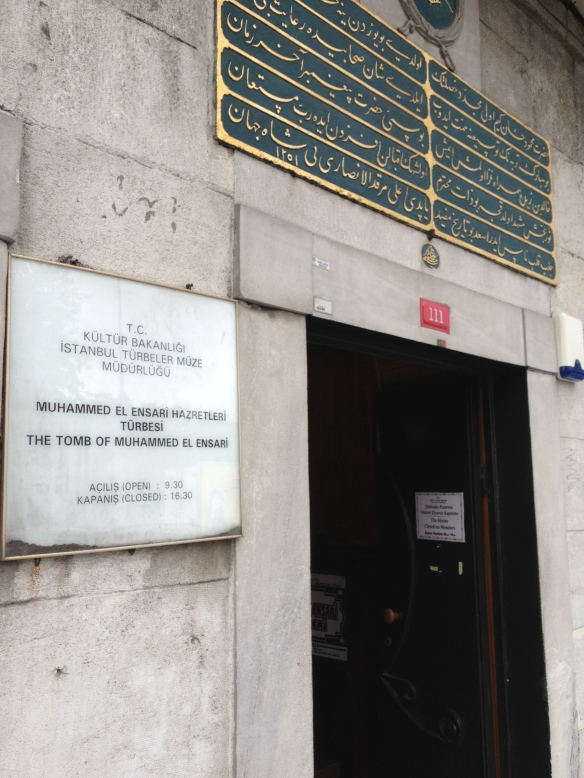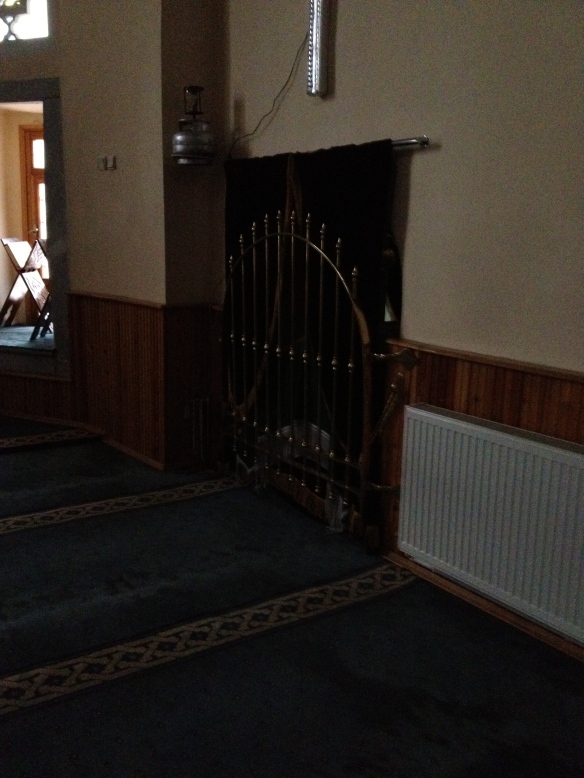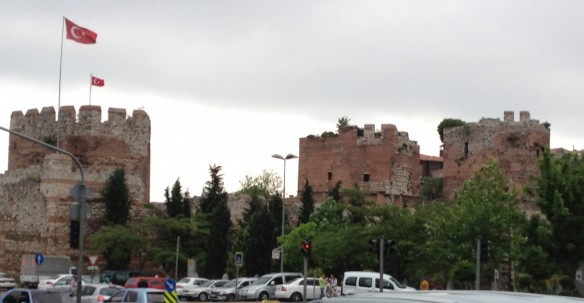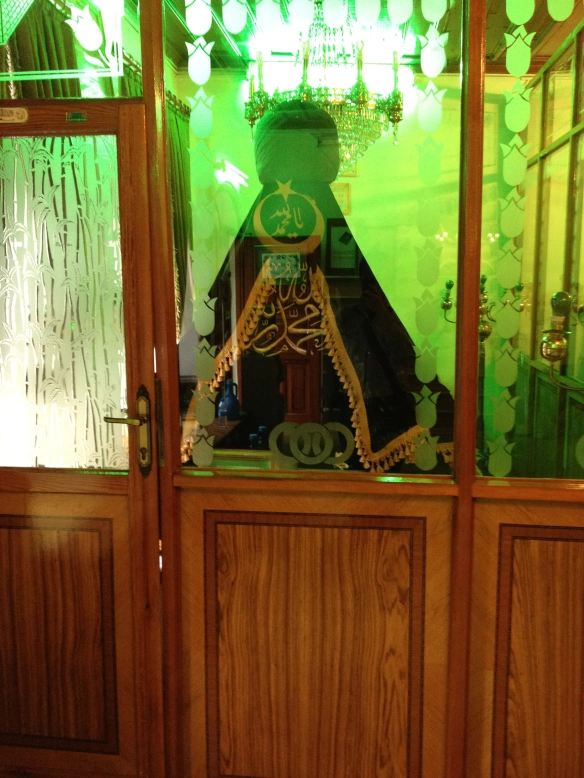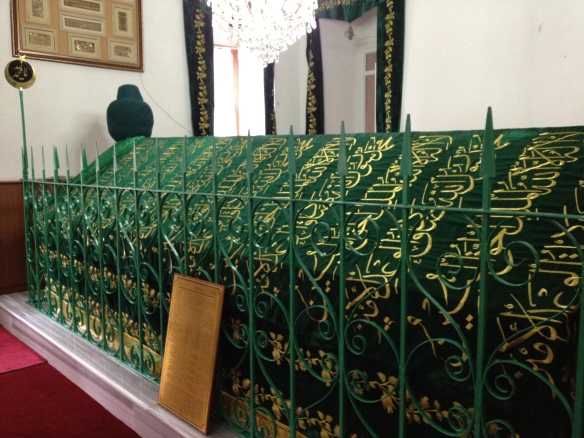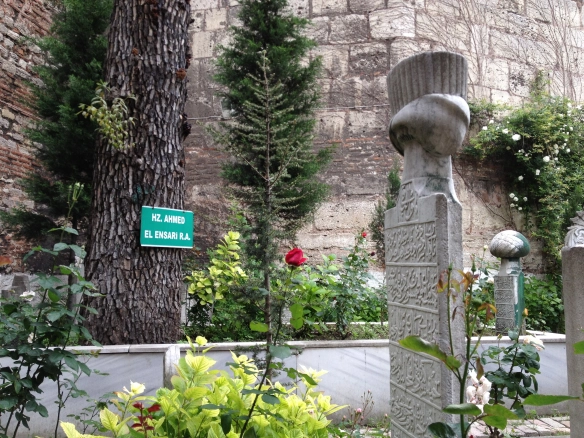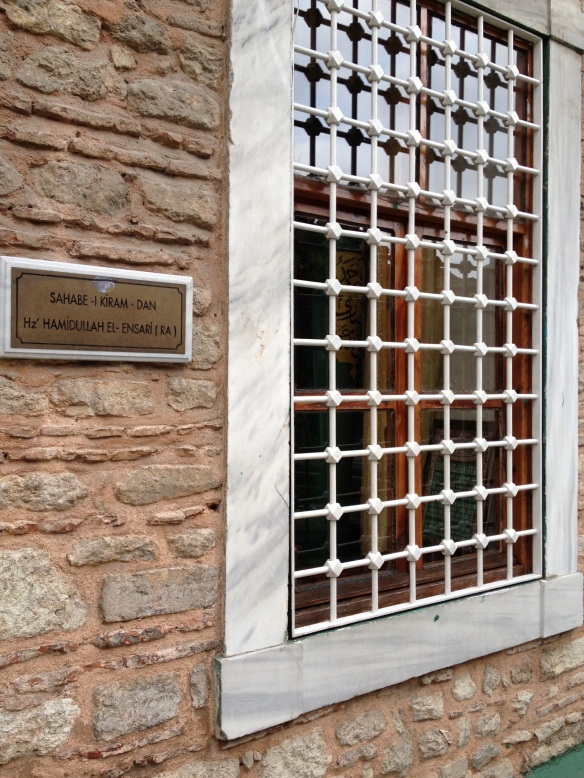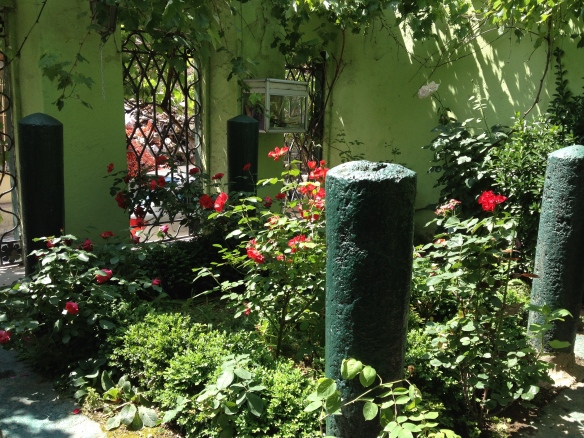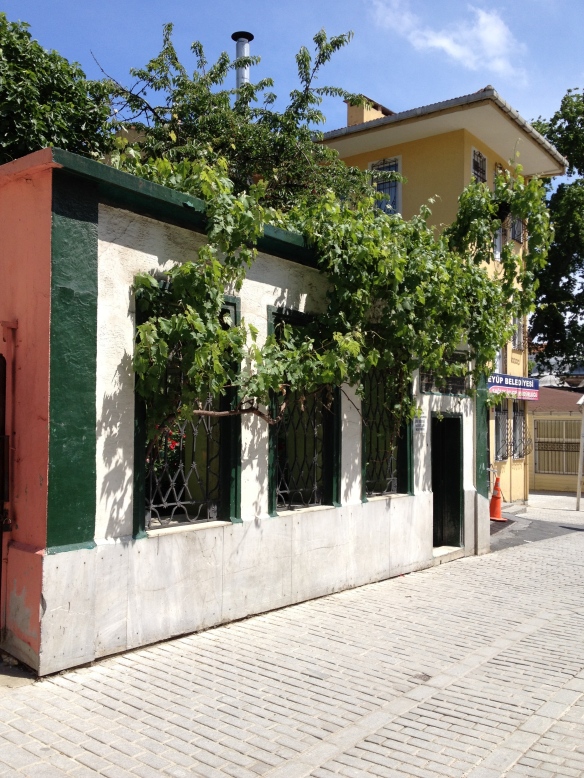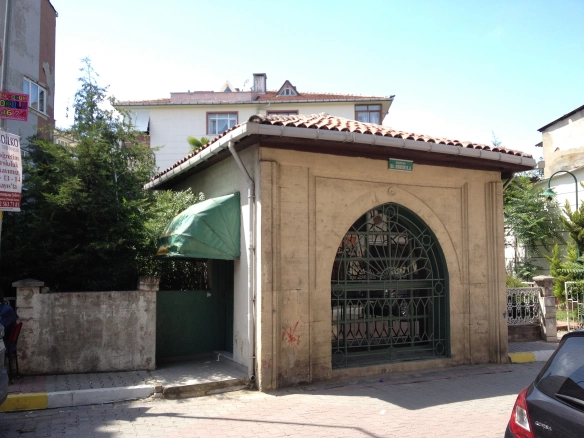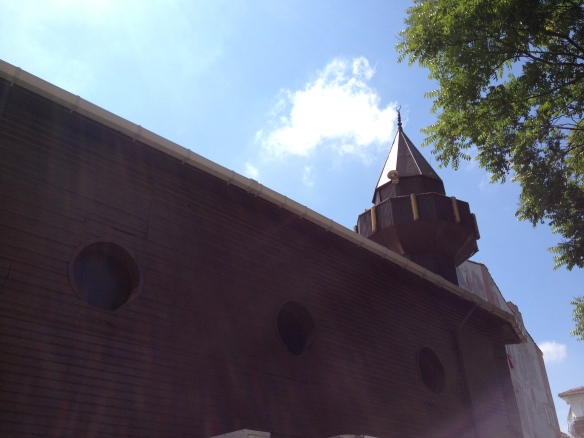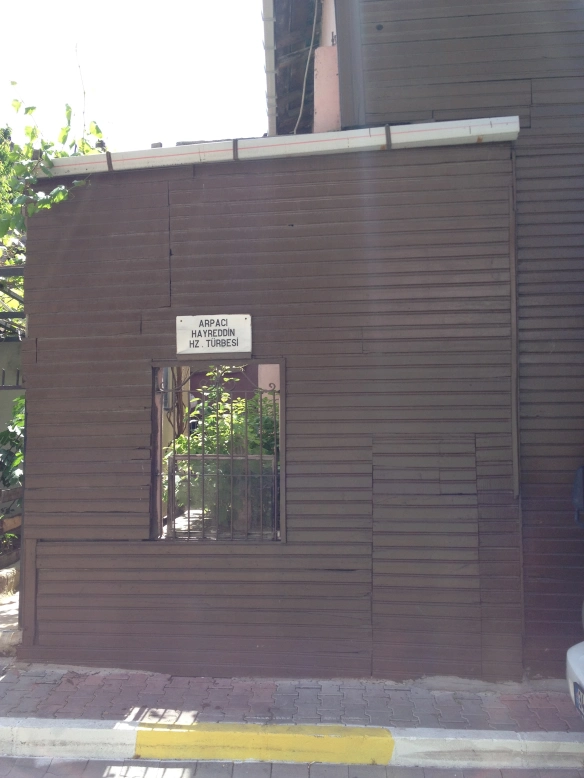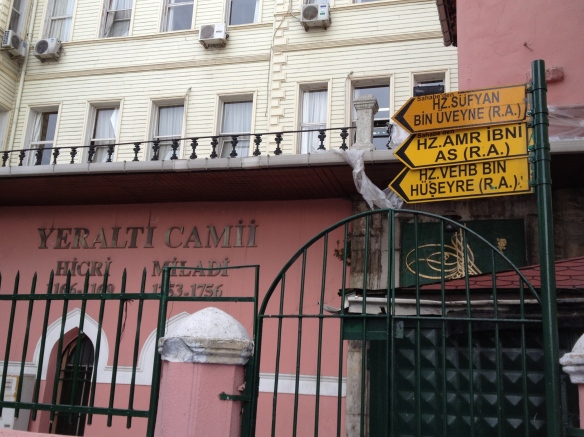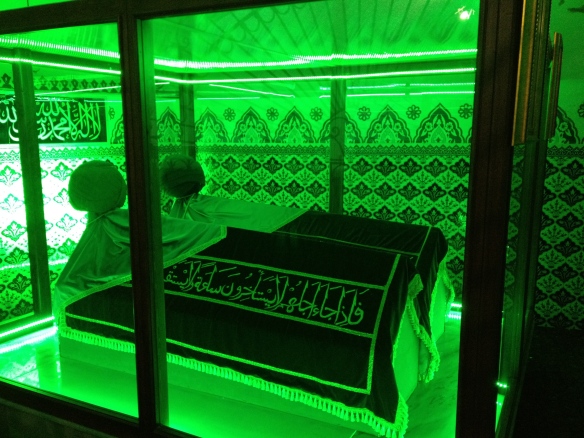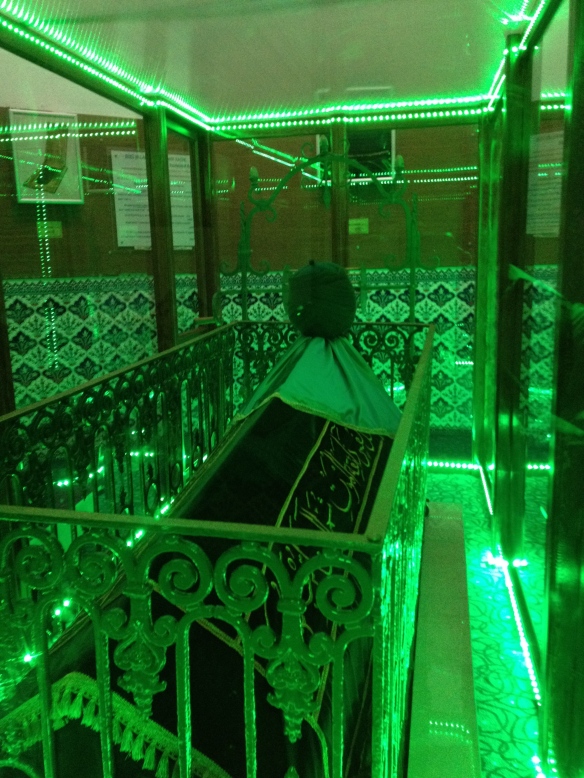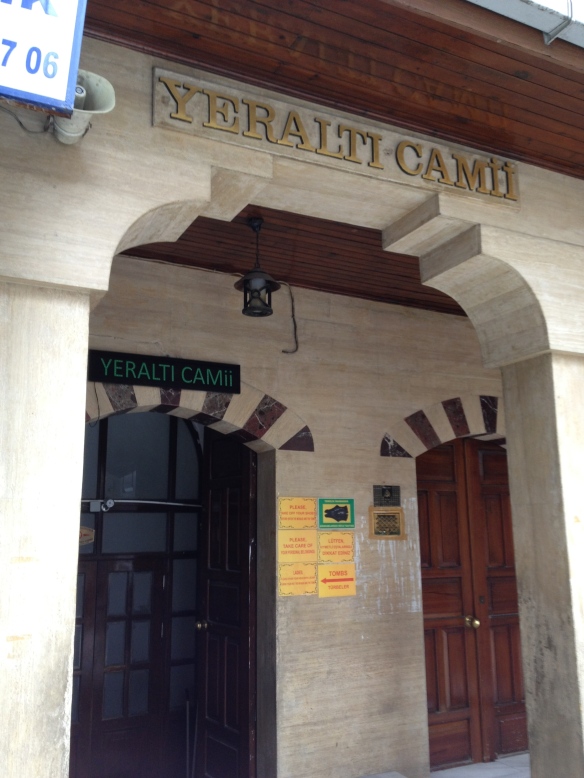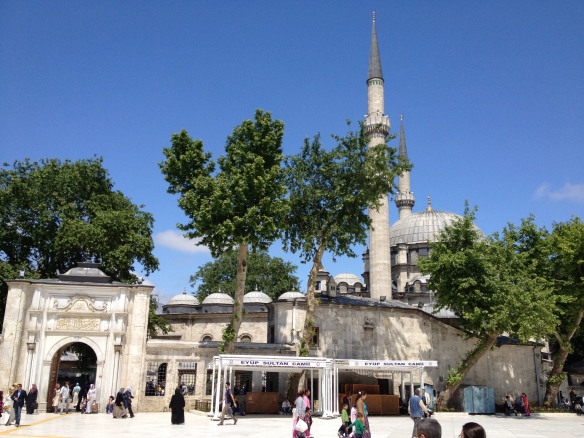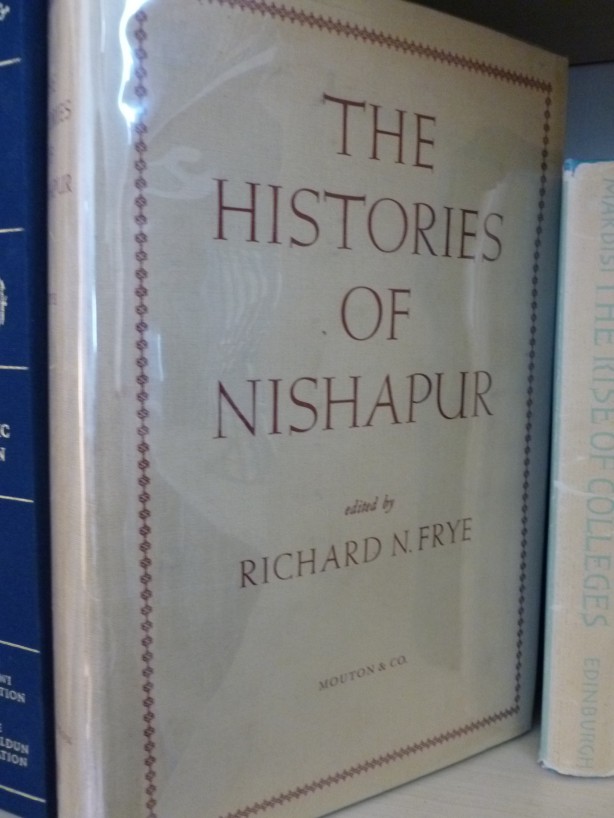South of Eyüp is the area of Ayvansaray. In this quiet residential neighborhood lie a number of tombs, but for this post we will focus on three noteworthy sites located by the Ayvansaray Coast along the waters of the Golden Horn. They are the tombs of Muḥammad al-Anṣārī (Muhammed el-Ensari), Abū Dharr al-Ghifārī (Ebuzer Gifari), and Jābir b. ‘Abd Allāh (Cabir bin Abdullah).
Yavedud Caddesi, a major thoroughfare, runs south out of Eyüp and passes beneath the towering Estuary (Haliç) Bridge. The road then becomes Ayvansaray Caddesi as it runs by the shrine complex in front of the old city walls, which we discussed in Part [4]. A block beyond the complex is a one-story building on the side of the street that houses the grave of Muhammad al-Anṣārī. The site can also be reached by ferry by disembarking from the Ayvansaray ferry station and cutting through the green space of Haliç Parkı. The white stone building is just on the other side of Ayvansaray Caddesi. The grave can be seen through a large window and should be open to the public for visitations.
Like the previously discussed Abū Aḥmad al-Anṣārī and Ḥamīd Allāh al-Anṣārī, it is difficult to confirm the precise identity of Muḥammad al-Anṣārī given the fairly generic names provided. Nonetheless, one person of the many possible Companions of the Prophet presents himself as a strong candidate, Muḥammad b. Maslama al-Anṣārī (d. 43/663). He appears in numerous accounts as participating in many of the raids and campaigns of the early Muslim community and was personally sent by the Prophet on a number of occasions. Biographies consistently note his slaying of Ka’b b. al-Ashraf. After the Prophet’s death, Muḥammad b. Maslama appears to have served both the Caliphs ‘Umar and ‘Uthmān while avoiding the civil strife (fitna) that ensued afterwards.
There are conflicting reports, however, about the date of his death, although all the sources agree that he died in Medina rather than the Byzantine frontier. Al-Ṭabarī, under the year 43 AH, reports, “In Ṣafar of this year (May 15 – June 12, 663) Muḥammad b. Maslamah died in al-Madinah. Marwān b. al-Ḥakam led the prayers over him” (al-Ṭabarī, History, 18:32). Ibn Sa’d reports his death in Ṣafar of the year 46 AH and also states that Marwān b. al-Ḥakam led the funeral prayer (Ibn Saʿd, Kitāb al-Ṭabaqāt al-kabīr, 3:410). The sources agree that Muḥammad b. Maslama was 77 years old when he died. Finally, Ibn ‘Abd al-Barr reports both the preceding dates of death and then adds the year 47 AH as a third possibility (Ibn ʿAbd al-Barr, al-Istīʿāb, 3:1377). Given his widely reported death in Medina, it is possible that another Muḥammad al-Anṣārī rests here.
Next, the mosque of Abū Dharr al-Ghifārī (d. 32/652-3), appropriately named Hazreti Ebuzer Gifari Camii, lies further inland. Several winding and uneven blocks away from Ayvansaray Caddesi where the tomb of Muḥammad al-Anṣārī lies sits this modest house of worship. Adorned with a single minaret, the mosque is enclosed by a low wall topped with an ironwork fence. The actual tomb rests outside of the mosque lying beneath the open sky and is easily visible from the sidewalk.
Concerning Abū Dharr’s life, J. Robson provides a summative overview in the second edition of Brill’s Encyclopaedia of Islam:
Abū Dharr al-Ghifārī, a Companion of Muḥammad. His name is commonly given as Djundub b. Djunāda, but other names are also mentioned. He is said to have worshipped one God before his conversion. When news of Muḥammad reached him he sent his brother to Mecca to make enquiries, and being dissatisfied with his report, he went himself. One story says he met Muḥammad with Abū Bakr at the Kaʿba, another that ʿAlī took him secretly to Muḥammad. He immediately believed, and is surprisingly claimed to have been the fifth (even the fourth) believer. He was sent home, where he stayed till he went to Medina after the battle of the Ditch (5/627). Later he lived in Syria till he was recalled by ʿUthmān because of a complaint against him by Muʿāwiya. He retired, or was sent, to al-Rabadha, where he died in 32/652-3, or 31. He was noted for humility and asceticism, in which respect he is said to have resembled Jesus. He was very religious and eager for knowledge, and is said to have matched Ibn Masʿūd in religious learning. He is credited with 281 traditions, of which al-Bukhārī and Muslim rendered 31 between them.
Abū Dharr al-Ghifārī was also given special recognition within the Sufi tradition, a point attested by his inclusion in John Renard’s Historical Dictionary of Sufism (2005), which has since been republished as The A to Z of Sufism (2009). Abū Dharr’s entry reads:
Abū Dharr al-Ghifārī (d. c. 32/653). Companion of the Prophet, ascetic, transmitter of Prophetic traditions, possibly one of the Helpers in Medina. His humility and simplicity were such that Sufis likened him to Jesus, who relied entirely on God. Tradition has it that a central theme in his public discourse was that those who have great wealth – indeed, any wealth at all – and refuse to spend in the cause of God will be punished for their lack of generosity. His piety was such that he was said to have engaged in the ritual prayer several years before he even met the Prophet. Some sources emphasize his personal intimacy with the Prophet, and that relationship together with his renunciation of wealth commended him to Sufis as a model of piety. (Renard, The A to Z, 23)
Author AbdulWāhid Hāmid provides even greater detail in the first volume of Companions of the Prophet. For instance, he claims that, “Abū Dharr was the first person to greet the Prophet with the greeting of Islam. After that, the greeting spread and came into general use” (Hāmid, Companions, 1:128-9). A short, but illustrative series of tales also concludes his biographical entry in this work:
Once a man visited him [Abū Dharr] and began looking at the contents of his house but found it quite bare. He asked Abū Dharr:
“Where are your possessions?”
“We have a house yonder (meaning the Hereafter),” said Abū Dharr, “to which we send the best of our possessions.”
The man understood what he meant and said: “But you must have some possessions so long as you are in this abode.”
“The owner of this abode will not leave us in it,” replied Abū Dharr.
Abū Dharr persisted in his simple and frugal life to the end. Once the amīr of Syria sent three hundred dinars to Abū Dharr to meet his needs. He returned the money saying, “Does not the amīr of Syria find a servant more deserving of it than I?”
In the year 32 AH, the self-denying Abū Dharr passed away. The Prophet, peace be upon him, had said of him: “The earth does not carry nor the heavens cover a man more true and faithful than Abū Dharr.” (Hāmid, Companions, 1:131-2)
While it appears that Abū Dharr al-Ghifārī died in al-Rabādha, a Muslim settlement in Western Arabia that later went into decline, it is clear that his religious significance continued to have great weight amongst the Ottomans of Istanbul to warrant a tomb there.
Swinging back towards the shores of the Golden Horn just two blocks away from Ebuzafer Camii and a block from Haliç Parkı is another mosque, Hazreti Cabir Camii. This small structure is easily recognized with its simple, white minaret and wood-paneled front. Inside the mosque and located off to the side in the main prayer space is the tomb of Jābir b. ‘Abd Allāh (d. 78/697). The grave lies hidden behind a dark green velvet curtain that is further barred by a golden gate.
‘Abd al-Ḥayy al-Lakhnawī provides a succinct account of Jābir’s life that draws upon a number of sometimes differing reports:
He went on expeditions with the Prophet nineteen times but he was not present at Badr. He died in Madīnah, but some say Makkah, in 78 AH, and others say 79 AH and even 74 AH. That is how it is in Is’āf al-mubaṭṭa’ of as-Suyūṭī. Jābir is Abū ‘Abdullāh Jābir ibn ‘Abdullah ibn ‘Amr ibn Ḥarām ibn ‘Amr ibn Sawād ibn Salamah al-Anṣārī one of the most famous of the Companions. He was present at Badr – according to what is said – and what came after it. His father was one of the twelve leading men [to pledge allegiance at al-‘Aqabah]. Jābir became blind at the end of his life, and he died in Madīnah in 74 AH, but some say 77 or 78 AH, and he was the last of the Companions to die in Madīnah. Thus it is in Jāmi’ al-uṣūl. (al-Lakhnawi, Rijal, p. 82)
M.J. Kister’s entry in Brill’s Encyclopaedia of Islam provides more extensive information. Concerning Jābir’s death, Kister writes:
Djābir died at 78/697 at the age of 94 (other reports, however, give varying dates). He is said to have been the last survivor of the group of 70 Anṣār who attended the ʿAḳaba Meeting, thus fulfilling a prediction of the Prophet. The prayer over his grave was performed by the governor of Medina, Abān b. ʿUthmān, or according to another tradition, by al-Ḥadjdjādj b. Yūsuf when he came to Medina after his victory over ʿAbd Allāh b. al-Zubayr.
More intriguing is the rich Shī’ī remembrance of him:
In Shīʿī tradition, Djābir was granted an exceptionally high rank. The ḥadīths recorded in Shīʿī sources on his authority touch upon the fundamental tenets of Shīʿī belief: the mission of ʿAlī, his qualities, his authority over the believers, the graces granted him by God, the divine virtues of his descendants and the duties of allegiance and obedience incumbent upon the believers. It was the imām al-Bāḳir who asked Djābir about the Tablet which God sent down to Fāṭima and which Djābir got permission to copy. In this Tablet God named the imāms and established their order of succession. It is noteworthy that, according to some versions, the imām compared the copy of Djābir with the Tablet in his possession and stated that the copy is a reliable and accurate one. In another story, Djābir confirms the accuracy of the unusual report about the hidjra as told him by the imām. Djābir is credited with the ḥadīth about the appointment of ʿAlī as waṣī, which forms the base of the Shīʿī interpretation of Sūra LIII, 1-4.
It appears that Jābir b. ‘Abd Allāh, like Muḥammad b. Maslama and Abū Dharr al-Ghifārī who preceded him, likely passed away far from the environs of Constantinople. Nevertheless, these modest grave sites scattered along the Ayvansaray Coast continue to attest to the sustained attention and devotion that the remembrance of these Companions command.
Hāmid, AbdulWāhid.1998. Companions of the Prophet, New Revised Edition. 2 vols. London: MELS.
Ibn ʿAbd al-Barr. 1992. al-Istīʿāb fī maʿrifat al-aṣḥāb, 1st edition, 4 vols. Beirut: Dār al-Jīl.
Kister, M. J.. “D̲j̲ābir b. ʿAbd Allāh.” Encyclopaedia of Islam, Second Edition. Brill Online, 2013. Reference. Fairfield University. 24 June 2013 <http://referenceworks.brillonline.com.libdb.fairfield.edu/entries/encyclopaedia-of-islam-2/djabir-b-abd-allah-SIM_8480>
al-Laknawī, Shaykh ‘Abd al-Ḥayy. 2004. Rijal: Narrators of the Muwatta al-Imam Muhammad. London: Ta-Ha Publishers, Ltd.
Muḥammad b. Saʿd al-Zuhrī. 2001. Kitāb al-Ṭabaqāt al-kabīr. 1st edition, 11 vols. Cairo: Maktabat al-Khānjī.
Renard, John. 2009. The A to Z of Sufism. Lanham, UK: The Scarecrow Press, Inc.
Robson, J. “Abū Ḏh̲arr.” Encyclopaedia of Islam, Second Edition. Brill Online, 2013. Reference. Fairfield University. 24 June 2013 <http://referenceworks.brillonline.com.libdb.fairfield.edu/entries/encyclopaedia-of-islam-2/abu-dharr-SIM_0173>
al-Ṭabarī, Muḥammad b. Jarīr. The History of al-Ṭabarī, Volume XVIII: Between Civil Wars: The Caliphate of Mu’āwiyah. Translated by Michael G. Morony. Albany: State University of New York Press, 1987.
To access the other posts in the series:
The Sahaba of Istanbul [1] Abu Ayyub al-Ansari
The Sahaba of Istanbul [2] The Underground Mosque
The Sahaba of Istanbul [3] Eyup
The Sahaba of Istanbul [4] The City Walls of Leo and Heraclius
The Sahaba of Istanbul [6] Galata/Eminonu/Sultanahmet (forthcoming)

